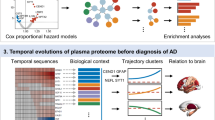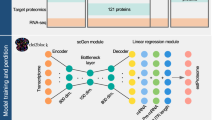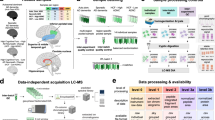Abstract
The mechanisms linking a history of major depressive disorder (MDD) to an increased risk of Alzheimer’s disease and related dementia (ADRD) are not fully understood. Using the UK Biobank, we evaluated the biological mechanisms linking the conditions. In participants without history of MDD, 493 proteins were significantly associated with the risk of ADRD. By contrast, in participants with a history of MDD at baseline, a smaller set of six proteins were significantly associated with ADRD risk (NfL, GFAP, PSG1, VGF, GET3 and HPGDS), with GET3 being specifically associated with ADRD risk in the latter group. Two-sample Mendelian randomization analysis showed that the apolipoprotein E and IL-10 receptor subunit B genes were causally linked to incident ADRD. Finally, we developed a proteomic risk score (PrRSMDD-ADRD), which showed strong discriminative power (C statistic = 0.84) to identify participants with MDD who developed ADRD on follow-up. Here we show that plasma proteins associated with inflammation and amyloid-β metabolism are causally linked to a higher ADRD risk in individuals with MDD. Moreover, the PrRSMDD-ADRD can be useful to identify individuals with the highest risk of developing ADRD in a highly vulnerable population.
This is a preview of subscription content, access via your institution
Access options
Subscribe to this journal
Receive 12 digital issues and online access to articles
$79.00 per year
only $6.58 per issue
Buy this article
- Purchase on SpringerLink
- Instant access to full article PDF
Prices may be subject to local taxes which are calculated during checkout




Similar content being viewed by others
Data availability
The analyses were done using the restricted and sensitive data from the UK Biobank dataset. These data are available on request following the UK Biobank policies.
Code availability
The code for the calculation of the PrRSMDD-ADRD is available at https://github.com/kuo-lab-uchc.
References
Morris, G. et al. Shared pathways for neuroprogression and somatoprogression in neuropsychiatric disorders. Neurosci. Biobehav. Rev. 107, 862–882 (2019).
Lynch, C. J., Gunning, F. M. & Liston, C. Causes and consequences of diagnostic heterogeneity in depression: paths to discovering novel biological depression subtypes. Biol. Psychiatry 88, 83–94 (2020).
Whiteford, H. A. et al. Global burden of disease attributable to mental and substance use disorders: findings from the Global Burden of Disease Study 2010. Lancet 382, 1575–1586 (2013).
Lorenzo, E. C., Kuchel, G. A., Kuo, C. L., Moffitt, T. E. & Diniz, B. S. Major depression and the biological hallmarks of aging. Ageing Res. Rev. 83, 101805 (2023).
Diniz, B. S. et al. Late-life depression and risk of vascular dementia and Alzheimer’s disease: systematic review and meta-analysis of community-based cohort studies. Br. J. Psychiatry 202, 329–335 (2013).
Ownby, R. L., Crocco, E., Acevedo, A., John, V. & Loewenstein, D. Depression and risk for Alzheimer disease: systematic review, meta-analysis, and metaregression analysis. Arch. Gen. Psychiatry 63, 530–538 (2006).
Barnes, D. E. & Yaffe, K. The projected effect of risk factor reduction on Alzheimer’s disease prevalence. Lancet Neurol. 10, 819–828 (2011).
Norton, S., Matthews, F. E., Barnes, D. E., Yaffe, K. & Brayne, C. Potential for primary prevention of Alzheimer’s disease: an analysis of population-based data. Lancet Neurol. 13, 788–794 (2014).
Livingston, G. et al. Dementia prevention, intervention, and care: 2024 report of the Lancet standing Commission. Lancet 404, 572–628 (2024).
Wilson, R. S. et al. Late-life depression is not associated with dementia-related pathology. Neuropsychology 30, 135 (2016).
Rhodes, E. et al. The impact of amyloid burden and APOE on rates of cognitive impairment in late life depression. J. Alzheimers Dis. 80, 991–1002 (2021).
Royall, D. R. & Palmer, R. F. Alzheimer’s disease pathology does not mediate the association between depressive symptoms and subsequent cognitive decline. Alzheimers Dement. 9, 318–325 (2013).
Gatchel, J. R. et al. Longitudinal association of depression symptoms with cognition and cortical amyloid among community-dwelling older adults. JAMA Netw. Open 2, e198964 (2019).
Mourao, R. J., Mansur, G., Malloy-Diniz, L. F., Castro Costa, E. & Diniz, B. S. Depressive symptoms increase the risk of progression to dementia in subjects with mild cognitive impairment: systematic review and meta-analysis. Int. J. Geriatr. Psychiatry 31, 905–911 (2016).
Lopez-Otin, C., Blasco, M. A., Partridge, L., Serrano, M. & Kroemer, G. Hallmarks of aging: an expanding universe. Cell 186, 243–278 (2023).
Gonzales, M. M. et al. Biological aging processes underlying cognitive decline and neurodegenerative disease. J. Clin. Invest. 132, e158453 (2022).
Diniz, B. S. et al. Plasma biosignature and brain pathology related to persistent cognitive impairment in late-life depression. Mol. Psychiatry 20, 594–601 (2015).
Diniz, B. S. et al. Mild cognitive impairment and major depressive disorder are associated with molecular senescence abnormalities in older adults. Alzheimers Dement. 7, e12129 (2021).
Taylor, W. D. et al. Hippocampus atrophy and the longitudinal course of late-life depression. Am. J. Geriatr. Psychiatry 22, 1504–1512 (2014).
Harerimana, N. V. et al. Genetic evidence supporting a causal role of depression in Alzheimer's disease. Biol. Psychiatry 92, 25–33 (2022).
Eldjarn, G. H. et al. Large-scale plasma proteomics comparisons through genetics and disease associations. Nature 622, 348–358 (2023).
Sun, B. B. et al. Plasma proteomic associations with genetics and health in the UK Biobank. Nature 622, 329–338 (2023).
Watanabe, K., Taskesen, E., van Bochoven, A. & Posthuma, D. Functional mapping and annotation of genetic associations with FUMA. Nat. Commun. 8, 1826 (2017).
Potter, G. G. et al. Neuropsychological predictors of dementia in late-life major depressive disorder. Am. J. Geriatr. Psychiatry 21, 297–306 (2013).
Marawi, T. et al. Brain–cognition associations in older patients with remitted major depressive disorder or mild cognitive impairment: a multivariate analysis of gray and white matter integrity. Biol. Psychiatry 94, 913–923 (2023).
Network, D. I. A. et al. Serum neurofilament dynamics predicts neurodegeneration and clinical progression in presymptomatic Alzheimer’s disease. Nat. Med. 25, 277–283 (2019).
Quinn, J. P., Kandigian, S. E., Trombetta, B. A., Arnold, S. E. & Carlyle, B. C. VGF as a biomarker and therapeutic target in neurodegenerative and psychiatric diseases. Brain Commun. 3, fcab261 (2021).
Ye, Q. et al. Low VGF is associated with executive dysfunction in patients with major depressive disorder. J. Psychiatr. Res. 152, 182–186 (2022).
Li, X. et al. Reduced serum VGF levels are linked with suicide risk in Chinese Han patients with major depressive disorder. BMC Psychiatry 20, 225 (2020).
Yu, L. et al. Associations of VGF with neuropathologies and cognitive health in older adults. Ann. Neurol. 94, 232–244 (2023).
Llano, D. A., Devanarayan, P. & Devanarayan, V. CSF peptides from VGF and other markers enhance prediction of MCI to AD progression using the ATN framework. Neurobiol. Aging 121, 15–27 (2023).
Huang, Z. et al. Th2A cells: the pathogenic players in allergic diseases. Front. Immunol. 13, 916778 (2022).
Chu, C., Wei, H., Zhu, W., Shen, Y. & Xu, Q. Decreased prostaglandin D2 levels in major depressive disorder are associated with depression-like behaviors. Int. J. Neuropsychopharmacol. 20, 731–739 (2017).
Maesaka, J. K. et al. Prostaglandin D2 synthase: apoptotic factor in alzheimer plasma, inducer of reactive oxygen species, inflammatory cytokines and dialysis dementia. J. Nephropathol. 2, 166–180 (2013).
Dai, H., Zhou, J. & Zhu, B. Gene co-expression network analysis identifies the hub genes associated with immune functions for nocturnal hemodialysis in patients with end-stage renal disease. Medicine 97, e12018 (2018).
Moore, T. & Dveksler, G. S. Pregnancy-specific glycoproteins: complex gene families regulating maternal-fetal interactions. Int. J. Dev. Biol. 58, 273–280 (2014).
Shahinian, J. H. et al. Pregnancy specific β-1 glycoprotein 1 is expressed in pancreatic ductal adenocarcinoma and its subcellular localization correlates with overall survival. J. Cancer 7, 2018–2027 (2016).
Denic, V., Dötsch, V. & Sinning, I. Endoplasmic reticulum targeting and insertion of tail-anchored membrane proteins by the GET pathway. Cold Spring Harb. Perspect. Biol. 5, a013334 (2013).
Colombo, S. F. et al. Tail-anchored protein insertion in mammals: function and reciprocal interactions of the two subunits of the TRC40 receptor. J. Biol. Chem. 291, 15292–15306 (2016).
Farrer, L. A. et al. Effects of age, sex, and ethnicity on the association between apolipoprotein E genotype and Alzheimer disease: a meta-analysis. JAMA 278, 1349–1356 (1997).
Makkar, S. R. et al. APOE ε4 and the influence of sex, age, vascular risk factors, and ethnicity on cognitive decline. J. Gerontol. A 75, 1863–1873 (2020).
Lescai, F. et al. An APOE haplotype associated with decreased ε4 expression increases the risk of late onset Alzheimer’s disease. J. Alzheimers Dis. 24, 235–245 (2011).
Narasimhan, S. et al. Apolipoprotein E in Alzheimer’s disease trajectories and the next-generation clinical care pathway. Nat. Neurosci. 27, 1236–1252 (2024).
Yamazaki, Y., Zhao, N., Caulfield, T. R., Liu, C.-C. & Bu, G. Apolipoprotein E and Alzheimer disease: pathobiology and targeting strategies. Nat. Rev. Neurol. 15, 501–518 (2019).
Goldmann, O., Nwofor, O. V., Chen, Q. & Medina, E. Mechanisms underlying immunosuppression by regulatory cells. Front. Immunol. 15, 1328193 (2024).
Liston, A., Dooley, J. & Yshii, L. Brain-resident regulatory T cells and their role in health and disease. Immunol. Lett. 248, 26–30 (2022).
Carlini, V. et al. The multifaceted nature of IL-10: regulation, role in immunological homeostasis and its relevance to cancer, COVID-19 and post-COVID conditions. Front. Immunol. 14, 1161067 (2023).
Lippitz, B. E. Cytokine patterns in patients with cancer: a systematic review. Lancet Oncol. 14, e218–e228 (2013).
Xu, M. et al. JAK inhibition alleviates the cellular senescence-associated secretory phenotype and frailty in old age. Proc. Natl Acad. Sci. USA 112, E6301–E6310 (2015).
Chaib, S., Tchkonia, T. & Kirkland, J. L. Cellular senescence and senolytics: the path to the clinic. Nat. Med. 28, 1556–1568 (2022).
Diniz, B. S., Reynolds Iii, C. F., Sibille, E., Bot, M. & Penninx, B. Major depression and enhanced molecular senescence abnormalities in young and middle-aged adults. Transl. Psychiatry 9, 198 (2019).
Lorenzo, E. C. et al. Unraveling the association between major depressive disorder and senescent biomarkers in immune cells of older adults: a single-cell phenotypic analysis. Front. Aging 5, 1376086 (2024).
Bartels, C., Wagner, M., Wolfsgruber, S., Ehrenreich, H. & Schneider, A. Impact of SSRI therapy on risk of conversion from mild cognitive impairment to Alzheimer's dementia in individuals with previous depression. Am. J. Psychiatry 175, 232–241 (2017).
Ramos‐Cejudo, J. et al. Antidepressant exposure and long‐term dementia risk in a nationwide retrospective study on US veterans with midlife major depressive disorder. Alzheimers Dement. 20, 4106–4114 (2024).
Sims, J. R. et al. Donanemab in early symptomatic Alzheimer disease. JAMA 330, 512–527 (2023).
Faquetti, M. L. et al. Baricitinib and tofacitinib off-target profile, with a focus on Alzheimer’s disease. Alzheimers Dement. 10, e12445 (2024).
Serrano-Pozo, A., Das, S. & Hyman, B. T. APOE and Alzheimer’s disease: advances in genetics, pathophysiology, and therapeutic approaches. Lancet Neurol. 20, 68–80 (2021).
Glanville, K. P. et al. Multiple measures of depression to enhance validity of major depressive disorder in the UK Biobank. BJPsych Open 7, e44 (2021).
Yang, L. et al. Depression, depression treatments, and risk of incident dementia: a prospective cohort study of 354,313 participants. Biol. Psychiatry 93, 802–809 (2023).
Kaup, A. R. et al. Trajectories of depressive symptoms in older adults and risk of dementia. JAMA Psychiatry 73, 525 (2016).
Torgo, L. Data Mining with R: Learning with Case Studies (Chapman and Hall/CRC, 2011).
Kuo, C.-L. et al. Proteomic aging clock (PAC) predicts age-related outcomes in middle-aged and older adults. Aging Cell 23, e14195 (2024).
Benjamini, Y. & Hochberg, Y. Controlling the false discovery rate: a practical and powerful approach to multiple testing. J. R. Stat. Soc. B 57, 289–300 (1995).
Davey Smith, G. & Ebrahim, S. What can Mendelian randomisation tell us about modifiable behavioural and environmental exposures? Brit. Med. J. 330, 1076–1079 (2005).
Evans, D. M. & Davey Smith, G. Mendelian randomization: new applications in the coming age of hypothesis-free causality. Annu. Rev. Genomics Hum. Genet. 16, 327–350 (2015).
Davies, N. M., Holmes, M. V. & Smith, G. D. Reading Mendelian randomisation studies: a guide, glossary, and checklist for clinicians. BMJ 362, k601 (2017).
Melzer, D. et al. A genome-wide association study identifies protein quantitative trait loci (pQTLs). PLoS Genet. 4, e1000072 (2008).
Fauman, E. B. & Hyde, C. An optimal variant to gene distance window derived from an empirical definition of cis and trans protein QTLs. BMC Bioinf. 23, 169 (2022).
Burgess, S., Butterworth, A. & Thompson, S. G. Mendelian randomization analysis with multiple genetic variants using summarized data. Genet. Epidemiol. 37, 658–665 (2013).
Bowden, J., Davey Smith, G. & Burgess, S. Mendelian randomization with invalid instruments: effect estimation and bias detection through Egger regression. Int. J. Epidemiol. 44, 512–525 (2015).
Zhao, Q., Wang, J., Hemani, G., Bowden, J. & Small, D. S. Statistical inference in two-sample summary-data Mendelian randomization using robust adjusted profile score. Ann. Stat. 48, 1742–1769 (2020).
Bowden, J. et al. Assessing the suitability of summary data for two-sample Mendelian randomization analyses using MR-Egger regression: the role of the I2 statistic. Int. J. Epidemiol. 45, 1961–1974 (2016).
Friedman, J., Hastie, T. & Tibshirani, R. Regularization paths for generalized linear models via coordinate descent. J. Stat. Softw. https://doi.org/10.18637/jss.v033.i01 (2010).
Gompertz, B. On the nature of the function expressive of the law of human mortality, and on a new mode of determining the value of life contingencies. Phil. Trans. R. Soc. Lond. 115, 513–583 (1825).
Harrell, F. E. Jr., Califf, R. M., Pryor, D. B., Lee, K. L. & Rosati, R. A. Evaluating the yield of medical tests. JAMA 247, 2543–2546 (1982).
Fawns-Ritchie, C. & Deary, I. J. Reliability and validity of the UK Biobank cognitive tests. PLoS ONE 15, e0231627 (2020).
Therneau, T. A package for survival analysis in R. R package version 3.5-8 (2024).
Simon, N., Friedman, J. H., Hastie, T. & Tibshirani, R. Regularization paths for Cox’s proportional hazards model via coordinate descent. J. Stat. Softw. https://doi.org/10.18637/jss.v039.i05 (2011).
Jackson, C. flexsurv: a platform for parametric survival modeling in R. J. Stat. Softw. https://doi.org/10.18637/jss.v070.i08 (2016).
Pilling, L. C. gwasRtools: some useful R functions for processing GWAS output. GitHub https://github.com/lcpilling/gwasRtools/(2024).
Yavorska, O. O. & Burgess, S. MendelianRandomization: an R package for performing Mendelian randomization analyses using summarized data. Int. J. Epidemiol. 46, 1734–1739 (2017).
Acknowledgements
This research was supported by NIH grant P30AG067988 and has been conducted using the UK Biobank Resource under Application Number 92647, ‘Research to Inform the Field of Precision Gerontology’ (principal investigator R. H. Fortinski). In particular, this work uses data provided by patients and collected by the NHS as part of their care and support.
Author information
Authors and Affiliations
Contributions
B.S.D.: study conception and design, result interpretation, paper draft, and revision. Z.C.: data analysis, result interpretation, and paper review. D.C.S.: result interpretation and paper review. L.P.: consulted on data analysis, result interpretation, and paper review. Y.N., K.C.: figure preparation, result interpretation, and paper review. R.H.F. and G.A.K.: result interpretation and paper review. C.-L.K.: study conception and design, data analysis, result interpretation, paper draft, and revision.
Corresponding author
Ethics declarations
Competing interests
B.S.D. serves as a consultant to Bough Bioscience Inc in an area unrelated to this work. The other authors declare no competing interests.
Peer review
Peer review information
Nature Mental Health thanks Julius Popp, Lin Sun and the other, anonymous, reviewer(s) for their contribution to the peer review of this work.
Additional information
Publisher’s note Springer Nature remains neutral with regard to jurisdictional claims in published maps and institutional affiliations.
Supplementary information
Supplementary Information
Supplementary Figs. 1–3.
Supplementary Tables
Supplementary Tables 1–12.
Source data
Source Data Fig. 1
Statistical source data.
Source Data Fig. 2
Statistical source data.
Source Data Fig. 4
Statistical source data.
Rights and permissions
Springer Nature or its licensor (e.g. a society or other partner) holds exclusive rights to this article under a publishing agreement with the author(s) or other rightsholder(s); author self-archiving of the accepted manuscript version of this article is solely governed by the terms of such publishing agreement and applicable law.
About this article
Cite this article
Diniz, B.S., Chen, Z., Steffens, D.C. et al. Proteogenomic signature of Alzheimer’s disease and related dementia risk in individuals with major depressive disorder. Nat. Mental Health 3, 879–888 (2025). https://doi.org/10.1038/s44220-025-00460-0
Received:
Accepted:
Published:
Issue date:
DOI: https://doi.org/10.1038/s44220-025-00460-0



